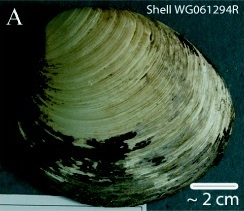Biology:Ming (clam)
 Left valve of the shell, taken in 2006. The clam was 507 years old when captured. | |
| Other name(s) | Hafrún |
|---|---|
| Species | Arctica islandica (ocean quahog clam) |
| Sex | Unknown |
| Hatched | c. Template:Birth based on age at death Off the coast of the Crown Dependency of Iceland, Kingdom of Norway, Kalmar Union |
| Died | Template:Death year and given age Off the coast of Iceland |
| Cause of death | Freezing |
| Known for | Oldest individual animal ever discovered |
| Named after | Chinese dynasty during which it was born |
Ming (c. 1498 or 1499–2006), also known as Hafrún, was an ocean quahog clam (Arctica islandica, family Arcticidae) that was dredged off the coast of Iceland in 2006 and whose age was calculated by counting annual growth lines in the shell. Ming was the oldest individual (non-colonial) animal ever discovered whose age could be precisely determined.[1][2][3]
Thought to be 405 years old, Ming was later determined to be 507 years old, although the clam had previously been killed to make this determination. The size of the clam was 87 mm × 73 mm (3.4 in × 2.9 in).
Name
The clam was initially named Ming by Sunday Times journalists, in reference to the Ming dynasty in China , during which it was born.[1] Later, the Icelandic researchers on the cruise which discovered the clam named it Hafrún, a woman's name which translates roughly as 'the mystery of the ocean'; taken from haf, 'ocean', and rún, 'mystery').[4] The actual sex of the clam, however, is unknown, as its reproductive state was recorded as "spent".
Original discovery
The clam was dredged off the northern coast of Iceland in 2006. In 2007, on the basis of counting the annual growth bands on the cross-sectional surface of the hinge region of the shell, researchers announced that the clam was 405 years old.[5] The research was carried out by researchers from Bangor University. In the process, the clam died.[2][6][7]
Professor Richardson said that the existence of such long-lived species could help scientists discover how some animals reach such advanced ages.[7]
The mollusk's long life came to an end in 2006 when the researchers—unaware of the animal's exceptional age—froze the specimen, killing it in the process.[8]
Revision of age
In 2013, another assessment of the age of the clam was carried out counting bands which were measured on the sectioned surface of the outer shell margin[9] and this was verified by comparing the banding patterns with those on other shells that were alive at the same time; this confirmed that the clam was 507 years old when it was caught.[3][8] The revised age estimate is also supported by carbon-14 dating; marine biologist Rob Witbaard commented that he considers this second assessment accurate to within 1–2 years.[8]
See also
- List of long-living organisms
References
- ↑ Jump up to: 1.0 1.1 Farrar, Steve (2007-10-28). "Ming the mollusc holds secret to long life". The Sunday Times (London). https://www.thetimes.co.uk/article/ming-the-mollusc-holds-secret-to-long-life-mfcvbtxl6gr. Retrieved 2013-09-01.
- ↑ Jump up to: 2.0 2.1 Alleyne, Richard (2007-10-28). "Clam, 405, is oldest animal ever". The Daily Telegraph (London). https://www.telegraph.co.uk/news/uknews/1567562/Clam,-405,-is-oldest-animal-ever.html. Retrieved 2008-07-26.
- ↑ Jump up to: 3.0 3.1 Butler, Paul G.; Wanamaker, Alan D.; Scourse, James D.; Richardson, Christopher A.; Reynolds, David J. (2013). "Variability of marine climate on the North Icelandic Shelf in a 1357-year proxy archive based on growth increments in the bivalve Arctica islandica". Palaeogeography, Palaeoclimatology, Palaeoecology 373: 141–151. doi:10.1016/j.palaeo.2012.01.016. Bibcode: 2013PPP...373..141B.
- ↑ "Kúskelin Hafrún var orðin 507 ára" (in Icelandic). Morgunblaðið (Reykjavik). 2013-11-16. http://www.mbl.is/frettir/innlent/2013/11/16/kuskelin_hafrun_var_ordin_507_ara/.
- ↑ Wanamaker Jr., Alan D.; Heinemeier, Jan; Scourse, James D.; Richardson, Christopher A.; Butler, Paul G.; Eiriksson, Jón; Knudsen, Karen L. (2008). "Very Long-Lived Mollusks Confirm 17th Century AD Tephra-Based Radiocarbon Reservoir Ages for North Icelandic Shelf Waters". Radiocarbon 50 (3): 399-412. doi:10.1017/S0033822200053510. https://repository.arizona.edu/bitstream/handle/10150/654085/3222-4117-1-PB.pdf?sequence=1&isAllowed=y.
- ↑ "405-yr-old clam dredged from the deep". ABC News. 2007-10-29. http://www.abc.net.au/news/stories/2007/10/29/2072637.htm. Retrieved 2007-10-29.
- ↑ Jump up to: 7.0 7.1 "Ming the clam is oldest mollusc". BBC News. 2007-10-28. http://news.bbc.co.uk/2/hi/science/nature/7066389.stm. Retrieved 2010-05-12.
- ↑ Jump up to: 8.0 8.1 8.2 Lise Brix (2013-11-06). "New record: World's oldest animal is 507 years old". Sciencenordic. Archived from the original on 2013-11-15. https://archive.today/20131115121158/http://sciencenordic.com/new-record-world%E2%80%99s-oldest-animal-507-years-old. Retrieved 2013-11-14.
- ↑ Scourse, J.; Richardson, C.; Forsythe, G.; Harris, I.; Heinemeier, J.; Fraser, N.; Briffa, K.; Jones, P. (2006). "First cross-matched floating chronology from the marine fossil record: Data from growth lines of the long-lived bivalve mollusc Arctica islandica". The Holocene 16 (7): 967. doi:10.1177/0959683606hl987rp. Bibcode: 2006Holoc..16..967S.
 |


